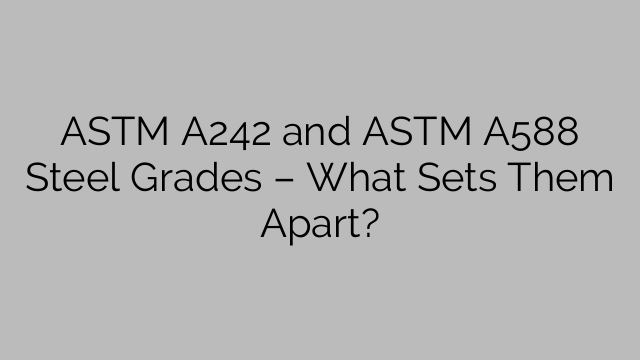ASTM A242 and ASTM A588 are two commonly used steel grades in construction and engineering applications. Although they have some similarities, there are key differences that set them apart. Understanding these differences is important for choosing the right steel grade for your specific project.
ASTM A242 is a high-strength low-alloy structural steel specification. It is predominantly used in outdoor applications such as bridges, buildings, and large structural steel shapes. This steel grade offers excellent corrosion resistance and is commonly referred to as “weathering steel” due to its ability to withstand outdoor elements. ASTM A242 steel develops a patina or protective layer of rust when exposed to weathering conditions. This rust layer acts as a barrier and protects the underlying steel from further corrosion, eliminating the need for additional protective coatings.
On the other hand, ASTM A588 is also a high-strength low-alloy steel grade designed for outdoor applications. It offers similar corrosion resistance as ASTM A242 but possesses additional mechanical properties, making it suitable for more demanding conditions. ASTM A588 steel is known for its enhanced tensile strength, as it contains additional alloys like copper, nickel, and chromium. These elements not only enhance the overall strength of the steel but also improve its atmospheric corrosion resistance.
One of the key differences between ASTM A242 and ASTM A588 is their yield strength. ASTM A242 has a minimum yield strength of 50,000 psi, which is suitable for many applications. ASTM A588, on the other hand, has a minimum yield strength of 50,000 psi and a minimum tensile strength of 70,000 psi. This higher tensile strength makes ASTM A588 steel ideal for heavy-duty applications where structural stability is crucial.
Another difference between these two steel grades is their availability. ASTM A242 steel is widely available and commonly used in a variety of industries. Its cost-effectiveness and excellent corrosion resistance make it a popular choice for many projects. On the other hand, ASTM A588 steel may be less readily available and may command a higher price due to its enhanced mechanical properties.
When choosing between ASTM A242 and ASTM A588 steel grades, it is essential to consider factors such as project requirements, environmental conditions, and budget constraints. ASTM A242 is suitable for applications that require good corrosion resistance in moderate environments. It is a cost-effective option for many projects. In contrast, ASTM A588 steel offers superior tensile strength and improved corrosion resistance, making it more suitable for demanding conditions and heavy-duty applications.
In conclusion, while both ASTM A242 and ASTM A588 are high-strength low-alloy steel grades that offer excellent corrosion resistance, ASTM A588 stands out with its enhanced mechanical properties. The increased tensile strength and additional alloying elements make it ideal for projects that require superior structural stability. Understanding these differences will help engineers and constructors make informed decisions when selecting the appropriate steel grade for their specific requirements.

